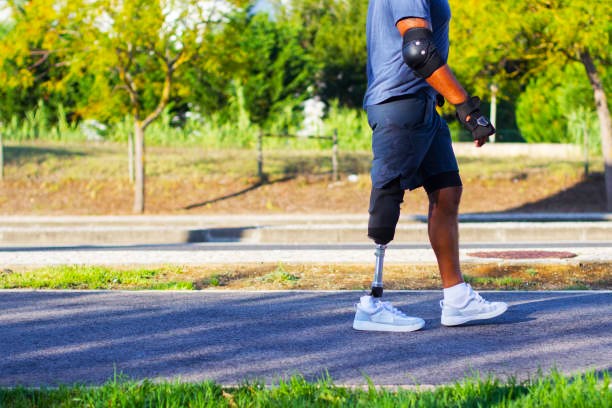
How is Robotic Knee Replacement Surgery Performed?
One of the newest developments in computerized surgery is robotic-assisted knee joint replacement surgery. This novel method allows for a new level of precision in implant placing by utilizing Computed Tomography (CT) scans to create a virtual model of the patient’s knee. In fact, some more recent systems do not even require a CT scan. We have Best Robotic Knee Replacement Surgeon in Navi Mumbai.
In order to access the knee during the procedure, the surgeon makes tiny incisions. The surgeon may precisely evaluate the ligaments’ state and the wear and tear on the knee by using the robotic system’s probe. This data is used to create a surgical plan, and the robotic arm—which may be outfitted with a saw or a burr-based system—is used to prepare the bone.
All the information on the accuracy, which is usually less than 0.5mm or 0.5 degrees, is shown on the screen of the robotic system. Throughout the process, the surgeon has complete control over the robotic arm to ensure patient safety.
Correct placement of the prosthesis results in reduced discomfort, according to patient reports in the two weeks after surgery. Additionally, the chance of infection and blood loss is decreased. Therefore get in touch with us because we have Best Robotic Knee Replacement Surgeon in Kharghar.
Robotic Knee Replacement Surgery Advantages and Types
Dr. Saurabh Kulkarni is the Best Robotic knee Replacement Surgeon in Vashi. Also Robotic knee replacement surgery is a sophisticated technique that uses robotics to improve knee joint replacement accuracy and precision. Compared to conventional knee replacement procedures, this method has a number of advantages, such as better results, quicker recovery periods, and higher patient satisfaction. Robotically aided total knee replacement and robotically assisted partial knee replacement are the two primary kinds of robotic knee replacement operations.
Benefits of Robotic Knee Replacement Surgery
- Enhanced Accuracy:
Surgeons can view the intricate, three-dimensional anatomy of a patient’s knee thanks to robotic technology. As a result, the procedure can be precisely planned and carried out, guaranteeing the best possible implant alignment and placement. Precise positioning is essential to the knee implant’s durability and performance.
- Personalized Treatment:
With the use of robotic technology, a customized surgical plan that takes into account each patient’s particular anatomy can be created. Better results and increased patient satisfaction result from this personalization, which improves the implant’s fit and functionality. So visit to happy joints clinic now because we have Best Robotic Knee Replacement Surgeon in Kharghar.
- The Least Invasive Method:
Comparing robotic-assisted surgery to traditional procedures, smaller incisions are frequently required. Shorter hospital stays, less pain, and less tissue damage are the outcomes of this minimally invasive procedure. Patients usually recover more quickly and are able to resume their regular activities sooner.
- Better Joint Performance:
Robotic-assisted surgery’s accuracy guarantees that the implant is positioned optimally, lowering the possibility of problems such implant misalignment or loosening. Increased range of motion, better joint function, and increased mobility all result from this.
4. Lower Chance of Human Error:
Using robotic technology reduces the possibility of surgical errors being made by people. By helping the surgeon make accurate motions and corrections, the robotic device improves the procedure’s accuracy. So visit to our clinic now and consult with Dr. Saurabh Kulkarni who is the Best Robotic Knee Replacement Surgeon in Alibag.
Different Robotic Knee Replacement Procedure Types
- Robotic-Assisted Total Knee Replacement:
In this operation, a prosthetic implant is used to replace the complete knee joint. The robotic technology helps the surgeon precisely place the implant’s component parts and remove the damaged bone and cartilage. In most cases, patients with severe arthritis or considerable knee injury are advised to have this kind of surgery.
- Robotic-Assisted Partial Knee Replacement:
Alternatively referred to as a Unicompartmental knee replacement, this treatment preserves the good bone and tissue by replacing only the injured section of the knee joint. Accurately removing the damaged area and precisely placing the partial implant are made easier by the robotic system. Patients with arthritis limited to one knee compartment may benefit from this operation. We have Best Robotic Knee Replacement Surgeon in Vashi.
Robotic Knee Replacement Surgery Risks
Technical Mistakes:
While robotic systems increase accuracy, they can also lead to technological faults or malfunctions that could compromise surgical results.
- Extended Surgical Duration:
Occasionally, the use of robotic equipment might make surgery take longer than expected, increasing the chance of problems like blood clots or infections.
- The Learning Curve
Specialized training is necessary for surgeons to effectively use robotic devices. Surgeons with limited expertise could encounter a challenging learning curve, which could affect the procedure’s outcome.
- Price:
Owing to the cost of the robotic technology and the additional training needed for physicians, knee replacement surgery performed by robotics may be more expensive than surgery performed using traditional methods.
Conclusion
Dr. Saurabh Kulkarni is known as the Best Robotic Knee Replacement Surgeon in Navi Mumbai. Also Robotic knee replacement surgery is a major development in orthopedics with many advantages over more conventional techniques. This surgical method is becoming more and more popular due to its improved joint performance, minimally invasive techniques, more precision, and decreased danger of human mistake. Robotic-assisted whole and partial knee replacement procedures can lead to improved patient outcomes, shortened recovery periods, and an improved quality of life overall. Robotic knee replacement surgery is anticipated to grow in popularity and efficacy as a treatment option for people with severe knee dysfunction and pain as technology advances.
